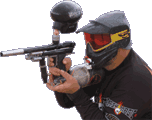  |
|
|
|
|
|
|
  |
|
|
|
|
|
|

What
do you think?
|

FireFox Throat Mic By Bill Mills - July 2004 A long standing rule in tournament paintball has been the prohibition of radios or communication devices, but that only applies to tournaments. In walk on play, and especially scenario paintball play where missions are coordinated across entire fields of play, the use of radios in paintball has flourished. In the 1980s, the limited range of citizen’s band and low power FM headset walkie-talkies kept their use pretty limited. CB based headset radios could be bought for around $30, but had a usable range of only around 50 feet. This limited them to small squad quiet communication. FM based systems selling for $100 to $150 a set boosted this range up to 100 to 200 feet and added voice activation capability. Beyond these systems, good communication required more expensive equipment which also required licensing to operate.
Many FRS radios are equipped with earphone and microphone jacks. For use in scenario paintball, or open woods play, the last thing a player wants after crawling to the perfect position to take out a group of players in ambush is to be given away by the sound of their radio as a team-mate calls them. Headsets which combine an earpiece with a small boom to hold a microphone near the mouth allow players to use their radio with little body movement, and a quiet voice. The drawback to a handheld or boom-mic arrangement is that in addition to the voice of its user, it also picks up the sounds of paintguns being fired around it, wind blowing on a players mask, and even the sounds of breathing against a mask. For players trying to use a voice activated mode radio (VOX), instead of a push-to-talk (PTT) system, they will be transmitting each time they fire their paintgun.
Anyone who has seen a movie about World War II era fighter or bomber crews has undoubtedly had a glimpse at the T-30 or similar throat microphone used by the Army Air Corps. The T-30 was developed by the Shure company to complete a very difficult task – pick up a person’s voice in a very noisy environment. Most microphones rely on sound waves coming through the air out of a person’s mouth to vibrate the mic element which converts the sound into an electronic signal. Throat mics get rid of the air in the middle by resting the microphone element on a person’s throat and picking up vibrations from that location. The result is that virtually all of the background noise is eliminated. FireFox Technologies has taken this concept and updated it with modern components to produce the FireFox throat mic, which they market to enthusiasts of a variety of outdoor activities such as motorcycle riding, snowboarding, and of course paintball.
The earpiece is an in-ear type, and is molded entirely from soft rubber. While it is soft, it rests in the outer ear, placing pressure on the ear, and for some users can become uncomfortable with time. FireFox offers an optional earpiece holder, which hooks over the ear and holds the earpiece onto the ear with only a very light pressure. Included in the Paintball throat-mic package is a push to talk button. The throat mic can be used as is with radios which offer voice activation. For those that do not, or for players who don’t want to broadcast their every word, the throat-mic can be plugged into the PTT adapter which plugs into the radio. The PTT button is about a half an inch by an inch in size and has a hook and loop wrist band allowing it to be worn like a wristwatch while the radio is tucked away in a convenient pocket or pouch.
In a few minutes time a splitter adapter was built to allow the throat-mic to be tested with the Realistic radio for review. As the radio used did not offer a VOX feature, all testing was done in push-to-talk mode. The PTT button proved to be much more convenient than having to reach to the radio for activation. A player can sit in a concealed position, and communicate quietly with very little movement.
FireFox Technologies throat mic made
an FRS radio much easier to use in paintball, and improved communication
capability by eliminating background noise. In comparing it to other
throat mic systems on the market, some of which cost hundreds of dollars,
the FireFox system is well suited for FRS use, and is surprisingly inexpensive
at a suggested retail price of less than forty dollars.
|
| Copyright © 1992-2019
Corinthian Media Services. WARPIG's webmasters can be reached through our feedback form. All articles and images are copyrighted and may not be redistributed without the written permission of their original creators and Corinthian Media Services. The WARPIG paintball page is a collection of information and pointers to sources from around the internet and other locations. As such, Corinthian Media Services makes no claims to the trustworthiness or reliability of said information. The information contained in, and referenced by WARPIG, should not be used as a substitute for safety information from trained professionals in the paintball industry. |